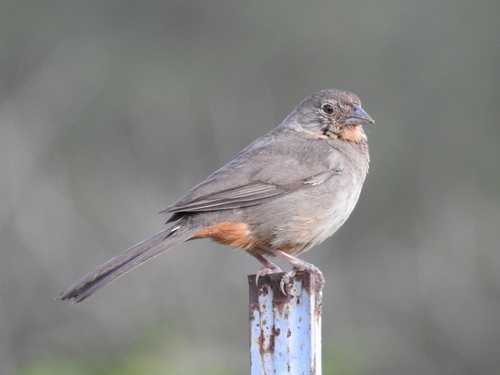
Canyon Towhee
The Canyon Towhee (*Melozone fusca*) is a large, ground-dwelling sparrow native to the southwestern United States and Mexico. It is well-adapted to arid and semi-arid environments, often found in brushy canyons and rocky hillsides. While not known for flashy plumage, its subtle beauty and distinctive calls make it a characteristic species of its habitat. The Canyon Towhee plays an important ecological role in seed dispersal and insect control. It holds no significant cultural significance beyond being a recognizable part of the regional avifauna.
20-25 cm
Length
25-30 cm
Wingspan
Least Concern
Conservation Status
Distribution
The Canyon Towhee's range extends from southeastern Colorado and western Oklahoma south through Arizona, New Mexico, and Texas, and into much of central Mexico. It is a non-migratory species, generally remaining in the same area year-round.
Lifespan
The average lifespan in the wild is estimated to be 3-4 years, although some individuals may live longer.
Canyon Towhee's Habitat
Habitat Types
Arid scrublands, Rocky canyons, Brushy hillsides, Chaparral, Pinyon-juniper woodlands
Climate Zones
Arid, Semi-arid, Temperate (with hot summers)
Adaptations
Their strong legs and feet are adapted for running and scratching on the ground. Their relatively drab coloration provides camouflage in their rocky, brushy habitat.
Variations
Numerous subspecies have been described, differing subtly in plumage coloration and size, reflecting adaptations to local conditions across their range.
Appearance
Breeding Plumage
Plumage is relatively consistent throughout the year, with no significant differences between breeding and non-breeding seasons.
Seasonal Feather Changes
No significant seasonal variation.
Sex Based Plumage Differences
Males and females are visually similar, exhibiting a generally brown plumage with a slightly darker tail and a buffy throat with fine streaks.
Notable Features
Long, dark tail, Buffy throat with fine streaks, Rufous undertail coverts, Overall brownish coloration
Diet and Feeding
Primary Foods
Seeds, Insects, Small invertebrates, Berries (occasionally)
Foraging Behavior
Canyon Towhees primarily forage on the ground, scratching and digging in leaf litter and soil with their feet to uncover seeds and insects. They often forage in pairs or small family groups.
Specializations
Their strong legs and feet are specialized for ground foraging.
Seasonal Diet Variations
The diet may shift slightly depending on the availability of food resources. Insects may be more prevalent in the diet during the breeding season, while seeds may form a larger proportion of the diet in winter.
Behavior
Social Structure
Canyon Towhees are generally found in pairs or small family groups. They are not highly social, but may form loose flocks outside of the breeding season.
Communication
A sharp, metallic *chink* call, A more complex song used for territorial defense and mate attraction, Scratching sounds made while foraging
Migration
Canyon Towhees are non-migratory, remaining in their breeding territories year-round.
Territorial or Group Behaviors
They are territorial during the breeding season, defending their nesting area from other Canyon Towhees. Pairs often forage together within their territory.
Conservation
Threats
Habitat loss and degradation due to urbanization and agriculture, Increased fire frequency in some areas, Pesticide use (indirectly, by reducing insect prey)
Protection Programs
General habitat conservation efforts in the southwestern US and Mexico
Local National Laws
Protected under the Migratory Bird Treaty Act in the United States (although it is non-migratory).
Population Trend
Stable
Population Estimates
The global population is estimated to be around 8.5 million individuals.
Interesting Facts
Canyon Towhees are known for their ground-foraging behavior.
They spend most of their time on the ground, hopping and scratching for food.
They are often seen running rather than flying.
Their strong legs allow them to move quickly across the ground.
They often flick or pump their tail.
This may be a form of communication or a way to maintain balance while moving.
Faqs about Canyon Towhee
What do Canyon Towhees eat?
They eat a variety of seeds, insects, and small invertebrates, foraging primarily on the ground.
Where do Canyon Towhees live?
They inhabit arid and semi-arid regions of the southwestern United States and Mexico, preferring brushy canyons and rocky hillsides.
Are Canyon Towhees migratory?
No, they are non-migratory and typically remain in the same area year-round.
What does a Canyon Towhee sound like?
It has sharp, metallic chink call and a more complex song, often described as a series of chipping notes.
Copyright @ Nature Style Limited. All Rights Reserved.
 English
English